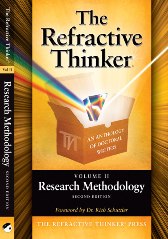The Refractive Thinker®: Vol. II: Research Methodology, Second Edition
The Benefits of Collaborative Doctoral Research
Celebrate the diffusion of innovative refractive thinking through the writings of these doctoral scholars as they dare to think differently in search of new applications and understandings of research methodology.
• Drs. Denise Land and Judy Fisher-Blando explore the benefits of case study methodology.
• Dr. Armando Salas-Amaro expands upon the qualitative multiple-case study method.
• Dr. Ramon L. Benedetto offers expertise about character-based culture through ethnographic research.
• Dr. Gillian Silver examines the benefits of Siedman’s (1998) exploratory multiple interview methodology.
• Dr. Susan Kristiniak explores phenomenology that offers the researcher the ability to become part of the data collection.
• Dr. Nathan Boyer offers perspective on the phenomenology approach regarding entrepreneurs and innovation.
• Dr. Leigh Riley examines a mixed method approach combining content analysis, quantitative design, and comparative analysis.
• Dr. Patricia Dues uses a quantitative correlational analysis with a mix of technology media using mixed methods.
• Dr. Gail Ferreira offers an array of digital methods to expand the results of mixed methods studies.
• Dr. Rachel Gonzales explores team effectiveness through a quantitative correlational method.
• Dr. Steven P. Woods demonstrates how refractive “out-of-the-box” thinking found new independent variables that were hiding in plain sight.
• Dr. Cheryl A. Lentz concludes with the future of innovative thought and the benefits of research and refractive thinking.
Unlike most academic books that merely define research, The Refractive Thinker® offers unique applications of research methodologies from the perspective of multiple authors—each offering a chapter based on their specific expertise.
The Benefits of Collaborative Doctoral Research
Celebrate the diffusion of innovative refractive thinking through the writings of these doctoral scholars as they dare to think differently in search of new applications and understandings of research methodology.
• Drs. Denise Land and Judy Fisher-Blando explore the benefits of case study methodology.
• Dr. Armando Salas-Amaro expands upon the qualitative multiple-case study method.
• Dr. Ramon L. Benedetto offers expertise about character-based culture through ethnographic research.
• Dr. Gillian Silver examines the benefits of Siedman’s (1998) exploratory multiple interview methodology.
• Dr. Susan Kristiniak explores phenomenology that offers the researcher the ability to become part of the data collection.
• Dr. Nathan Boyer offers perspective on the phenomenology approach regarding entrepreneurs and innovation.
• Dr. Leigh Riley examines a mixed method approach combining content analysis, quantitative design, and comparative analysis.
• Dr. Patricia Dues uses a quantitative correlational analysis with a mix of technology media using mixed methods.
• Dr. Gail Ferreira offers an array of digital methods to expand the results of mixed methods studies.
• Dr. Rachel Gonzales explores team effectiveness through a quantitative correlational method.
• Dr. Steven P. Woods demonstrates how refractive “out-of-the-box” thinking found new independent variables that were hiding in plain sight.
• Dr. Cheryl A. Lentz concludes with the future of innovative thought and the benefits of research and refractive thinking.
Unlike most academic books that merely define research, The Refractive Thinker® offers unique applications of research methodologies from the perspective of multiple authors—each offering a chapter based on their specific expertise.



